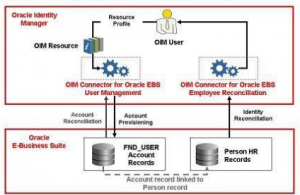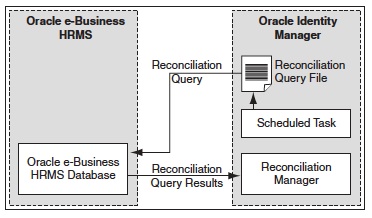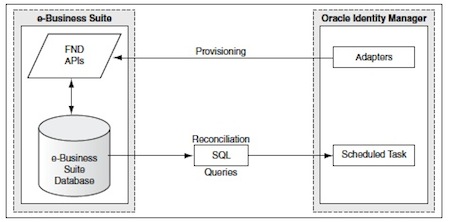Leave a Comment:
26 comments
Thank you so much for sharing this insight.Kind of in a hurry , but am sure this document is going to be very much helpful when I go through it, as had been your other posts to so many people like me.
Thanks Again,
I got “” error message when I provision eBS UM user with SSO enabled. Is there any example for the configuration with SSO enable?
Reply@ Victor Lin,
Are you provisioning EBS user via OIM (identity Manager) ?
Is OID (used by SSO and EBS) integarted with OIM using LDAP Sync or via LDAP Connector ?
Paste error as I can’t see error
ReplyHi Atul Kumar,
We use OIM to provision eBS user (EBSUM connector) and OID user (OID connector).
Here is the error from oim.out
=====================================
<oracle.iam.connectors.common.ConnectorException:
at oracle.iam.connectors.common.vo.ITResource.(Unknown Source)
at oracle.iam.connectors.ebs.usermgmt.integration.EBSUserManagement.initUtil(Unknown Source)
at sun.reflect.NativeMethodAccessorImpl.invoke0(Native Method)
at sun.reflect.NativeMethodAccessorImpl.invoke(NativeMethodAccessorImpl.java:39)
at sun.reflect.DelegatingMethodAccessorImpl.invoke(DelegatingMethodAccessorImpl.java:25)
at java.lang.reflect.Method.invoke(Method.java:597)
at com.thortech.xl.adapterGlue.ScheduleItemEvents.adpEBSCREATEUSER.INITUTIL(adpEBSCREATEUSER.java:181)
at com.thortech.xl.adapterGlue.ScheduleItemEvents.adpEBSCREATEUSER.implementation(adpEBSCREATEUSER.java:89)
at com.thortech.xl.client.events.tcBaseEvent.run(tcBaseEvent.java:196)
at com.thortech.xl.dataobj.tcDataObj.runEvent(tcDataObj.java:2492)
at com.thortech.xl.dataobj.tcScheduleItem.runMilestoneEvent(tcScheduleItem.java:2919)
at com.thortech.xl.dataobj.tcScheduleItem.eventPostInsert(tcScheduleItem.java:553)
at com.thortech.xl.dataobj.tcDataObj.insert(tcDataObj.java:604)
at com.thortech.xl.dataobj.tcDataObj.save(tcDataObj.java:474)
at com.thortech.xl.dataobj.tcORC.insertNonConditionalMilestones(tcORC.java:844)
at com.thortech.xl.dataobj.tcORC.completeSystemValidationMilestone(tcORC.java:1162)
at com.thortech.xl.dataobj.tcOrderItemInfo.completeCarrierBaseMilestone(tcOrderItemInfo.java:735)
at com.thortech.xl.dataobj.tcOrderItemInfo.eventPostInsert(tcOrderItemInfo.java:172)
at com.thortech.xl.dataobj.tcUDProcess.eventPostInsert(tcUDProcess.java:236)
at com.thortech.xl.dataobj.tcDataObj.insert(tcDataObj.java:604)
at com.thortech.xl.dataobj.tcDataObj.save(tcDataObj.java:474)
at com.thortech.xl.dataobj.tcTableDataObj.save(tcTableDataObj.java:2906)
at com.thortech.xl.ejb.beansimpl.tcFormInstanceOperationsBean.setProcessFormData(tcFormInstanceOperationsBean.java:710)
at com.thortech.xl.ejb.beansimpl.tcFormInstanceOperationsBean.setProcessFormData(tcFormInstanceOperationsBean.java:426)
at Thor.API.Operations.tcFormInstanceOperationsIntfEJB.setProcessFormDatax(Unknown Source)
at sun.reflect.NativeMethodAccessorImpl.invoke0(Native Method)
at sun.reflect.NativeMethodAccessorImpl.invoke(NativeMethodAccessorImpl.java:39)
at sun.reflect.DelegatingMethodAccessorImpl.invoke(DelegatingMethodAccessorImpl.java:25)
at java.lang.reflect.Method.invoke(Method.java:597)
at com.bea.core.repackaged.springframework.aop.support.AopUtils.invokeJoinpointUsingReflection(AopUtils.java:310)
at com.bea.core.repackaged.springframework.aop.framework.ReflectiveMethodInvocation.invokeJoinpoint(ReflectiveMethodInvocation.java:182)
at com.bea.core.repackaged.springframework.aop.framework.ReflectiveMethodInvocation.proceed(ReflectiveMethodInvocation.java:149)
at com.bea.core.repackaged.springframework.aop.support.DelegatingIntroductionInterceptor.doProceed(DelegatingIntroductionInterceptor.java:131)
at com.bea.core.repackaged.springframework.aop.support.DelegatingIntroductionInterceptor.invoke(DelegatingIntroductionInterceptor.java:119)
at com.bea.core.repackaged.springframework.aop.framework.ReflectiveMethodInvocation.proceed(ReflectiveMethodInvocation.java:171)
at com.bea.core.repackaged.springframework.jee.spi.MethodInvocationVisitorImpl.visit(MethodInvocationVisitorImpl.java:37)
at weblogic.ejb.container.injection.EnvironmentInterceptorCallbackImpl.callback(EnvironmentInterceptorCallbackImpl.java:54)
at com.bea.core.repackaged.springframework.jee.spi.EnvironmentInterceptor.invoke(EnvironmentInterceptor.java:50)
at com.bea.core.repackaged.springframework.aop.framework.ReflectiveMethodInvocation.proceed(ReflectiveMethodInvocation.java:171)
at com.bea.core.repackaged.springframework.aop.interceptor.ExposeInvocationInterceptor.invoke(ExposeInvocationInterceptor.java:89)
at com.bea.core.repackaged.springframework.aop.framework.ReflectiveMethodInvocation.proceed(ReflectiveMethodInvocation.java:171)
at com.bea.core.repackaged.springframework.aop.support.DelegatingIntroductionInterceptor.doProceed(DelegatingIntroductionInterceptor.java:131)
at com.bea.core.repackaged.springframework.aop.support.DelegatingIntroductionInterceptor.invoke(DelegatingIntroductionInterceptor.java:119)
at com.bea.core.repackaged.springframework.aop.framework.ReflectiveMethodInvocation.proceed(ReflectiveMethodInvocation.java:171)
at com.bea.core.repackaged.springframework.aop.framework.JdkDynamicAopProxy.invoke(JdkDynamicAopProxy.java:204)
at $Proxy349.setProcessFormDatax(Unknown Source)
at Thor.API.Operations.tcFormInstanceOperationsIntfEJB_h6wb8n_tcFormInstanceOperationsIntfRemoteImpl.__WL_invoke(Unknown Source)
at weblogic.ejb.container.internal.SessionRemoteMethodInvoker.invoke(SessionRemoteMethodInvoker.java:40)
at Thor.API.Operations.tcFormInstanceOperationsIntfEJB_h6wb8n_tcFormInstanceOperationsIntfRemoteImpl.setProcessFormDatax(Unknown Source)
at sun.reflect.NativeMethodAccessorImpl.invoke0(Native Method)
at sun.reflect.NativeMethodAccessorImpl.invoke(NativeMethodAccessorImpl.java:39)
at sun.reflect.DelegatingMethodAccessorImpl.invoke(DelegatingMethodAccessorImpl.java:25)
at java.lang.reflect.Method.invoke(Method.java:597)
at weblogic.ejb.container.internal.RemoteBusinessIntfProxy.invoke(RemoteBusinessIntfProxy.java:85)
at $Proxy187.setProcessFormDatax(Unknown Source)
at sun.reflect.NativeMethodAccessorImpl.invoke0(Native Method)
at sun.reflect.NativeMethodAccessorImpl.invoke(NativeMethodAccessorImpl.java:39)
at sun.reflect.DelegatingMethodAccessorImpl.invoke(DelegatingMethodAccessorImpl.java:25)
at java.lang.reflect.Method.invoke(Method.java:597)
at org.springframework.aop.support.AopUtils.invokeJoinpointUsingReflection(AopUtils.java:307)
at org.springframework.aop.framework.JdkDynamicAopProxy.invoke(JdkDynamicAopProxy.java:198)
at $Proxy347.setProcessFormDatax(Unknown Source)
at Thor.API.Operations.tcFormInstanceOperationsIntfDelegate.setProcessFormData(Unknown Source)
at com.thortech.xl.webclient.actions.DirectProvisionUserAction.handleVerifyProcessData(DirectProvisionUserAction.java:2077)
at com.thortech.xl.webclient.actions.DirectProvisionUserAction.goNext(DirectProvisionUserAction.java:363)
at sun.reflect.NativeMethodAccessorImpl.invoke0(Native Method)
at sun.reflect.NativeMethodAccessorImpl.invoke(NativeMethodAccessorImpl.java:39)
at sun.reflect.DelegatingMethodAccessorImpl.invoke(DelegatingMethodAccessorImpl.java:25)
at java.lang.reflect.Method.invoke(Method.java:597)
at org.apache.struts.actions.DispatchAction.dispatchMethod(DispatchAction.java:269)
at com.thortech.xl.webclient.actions.tcLookupDispatchAction.execute(tcLookupDispatchAction.java:133)
at com.thortech.xl.webclient.actions.tcActionBase.execute(tcActionBase.java:894)
at com.thortech.xl.webclient.actions.tcAction.execute(tcAction.java:213)
at org.apache.struts.chain.commands.servlet.ExecuteAction.execute(ExecuteAction.java:58)
at org.apache.struts.chain.commands.AbstractExecuteAction.execute(AbstractExecuteAction.java:67)
at org.apache.struts.chain.commands.ActionCommandBase.execute(ActionCommandBase.java:51)
at org.apache.commons.chain.impl.ChainBase.execute(ChainBase.java:191)
at org.apache.commons.chain.generic.LookupCommand.execute(LookupCommand.java:305)
at org.apache.commons.chain.impl.ChainBase.execute(ChainBase.java:191)
at org.apache.struts.chain.ComposableRequestProcessor.process(ComposableRequestProcessor.java:283)
at org.apache.struts.action.ActionServlet.process(ActionServlet.java:1914)
at org.apache.struts.action.ActionServlet.doPost(ActionServlet.java:463)
at javax.servlet.http.HttpServlet.service(HttpServlet.java:727)
at javax.servlet.http.HttpServlet.service(HttpServlet.java:821)
at weblogic.servlet.internal.StubSecurityHelper$ServletServiceAction.run(StubSecurityHelper.java:227)
at weblogic.servlet.internal.StubSecurityHelper.invokeServlet(StubSecurityHelper.java:125)
at weblogic.servlet.internal.ServletStubImpl.execute(ServletStubImpl.java:300)
at weblogic.servlet.internal.TailFilter.doFilter(TailFilter.java:27)
at weblogic.servlet.internal.FilterChainImpl.doFilter(FilterChainImpl.java:57)
at com.thortech.xl.webclient.security.CSRFFilter.doFilter(CSRFFilter.java:78)
at weblogic.servlet.internal.FilterChainImpl.doFilter(FilterChainImpl.java:57)
at oracle.iam.platform.auth.web.PwdMgmtNavigationFilter.doFilter(PwdMgmtNavigationFilter.java:122)
at weblogic.servlet.internal.FilterChainImpl.doFilter(FilterChainImpl.java:57)
at oracle.iam.platform.auth.web.OIMAuthContextFilter.doFilter(OIMAuthContextFilter.java:108)
at weblogic.servlet.internal.FilterChainImpl.doFilter(FilterChainImpl.java:57)
at oracle.security.jps.ee.http.JpsAbsFilter$1.run(JpsAbsFilter.java:111)
at oracle.security.jps.util.JpsSubject.doAsPrivileged(JpsSubject.java:313)
at oracle.security.jps.ee.util.JpsPlatformUtil.runJaasMode(JpsPlatformUtil.java:413)
at oracle.security.jps.ee.http.JpsAbsFilter.runJaasMode(JpsAbsFilter.java:94)
at oracle.security.jps.ee.http.JpsAbsFilter.doFilter(JpsAbsFilter.java:161)
at oracle.security.jps.ee.http.JpsFilter.doFilter(JpsFilter.java:71)
at weblogic.servlet.internal.FilterChainImpl.doFilter(FilterChainImpl.java:57)
at oracle.dms.servlet.DMSServletFilter.doFilter(DMSServletFilter.java:136)
at weblogic.servlet.internal.FilterChainImpl.doFilter(FilterChainImpl.java:57)
at weblogic.servlet.internal.RequestEventsFilter.doFilter(RequestEventsFilter.java:27)
at weblogic.servlet.internal.FilterChainImpl.doFilter(FilterChainImpl.java:57)
at weblogic.servlet.internal.WebAppServletContext$ServletInvocationAction.wrapRun(WebAppServletContext.java:3715)
at weblogic.servlet.internal.WebAppServletContext$ServletInvocationAction.run(WebAppServletContext.java:3681)
at weblogic.security.acl.internal.AuthenticatedSubject.doAs(AuthenticatedSubject.java:321)
at weblogic.security.service.SecurityManager.runAs(SecurityManager.java:120)
at weblogic.servlet.internal.WebAppServletContext.securedExecute(WebAppServletContext.java:2277)
at weblogic.servlet.internal.WebAppServletContext.execute(WebAppServletContext.java:2183)
at weblogic.servlet.internal.ServletRequestImpl.run(ServletRequestImpl.java:1454)
at weblogic.work.ExecuteThread.execute(ExecuteThread.java:209)
at weblogic.work.ExecuteThread.run(ExecuteThread.java:178)
Caused by: Thor.API.Exceptions.tcAPIException: Row index out of bounds
at Thor.API.tcMetaDataSet.goToRow(tcMetaDataSet.java:870)
… 115 more
>
Below is the eBS UM resource configuration.
SSO Enabled: yes
SSO IT Resource: OID Staff IT Resource
SSO Identifier: orclGUID
SSO Login Attribute: uid
Hi Victor,
I am in need of EBS UM connector version: 9.1.0.4. to integrate it with EBS 11.5.10.
Can you please provide its binaries if you have ? It is just few years ago that you configured 🙂
Regards,
Muhammad
Hi Atul,
Any information require for your checking? I look forward to your reply.
Thanks for your kind assistance!
Victor
Hi Atul,
Truly appreciate your effort in putting this information for OIM folks.
I have a query – What are the drawbacks of having both connectors? want more information when you said “It is recommended NOT to configure Oracle e-Business Employee Reconciliation and Oracle e-Business User Management with HRMS (HRF or HR Foundation) both at same time.”
Thanks,
Nitin
@ Nitin,
If you configure bith EBS Employee Recon and EBS USER management with HR then one will create user in FND table and PER tables EBS-ER will again try to sync them to OIM. Why do you want to install both connectors ?
What is requirement ?
ReplyHi Atul,
I don’t have any specific requirement, was just trying to understand. I understand that EBS UM connector shouldn’t provision to PERSON Table because it is configured as trusted source in EBS ER. You said it is “not recommended” and you didn’t say that it shouldn’t be done therefore wanted to dig more on the use case where we would need to have both and if we have both then what should be the approach – just need your expert comments.
Thanks,
Nitin
[…] E-Business Suite with Oracle Internet Directory (OID) and Oracle Identity Manager (OIM) (without Oracle EBS connectors) then users from EBS to OID are synced via EBS Provisioning Profile. These user in OID are then […]
ReplyAtul,
Is it possible to use the IT Resource that exists for LDAP sync (by default called “Directory Server”) as the SSO IT resource for EBS integration or should I setup an OID Connector that is pointed to the same directory?
Hoping not to have to use a new OID connector, but I thought you may have had experience with this.
Kind Regards,
Jerry
Reply@ PezGod.
OID connector is not required if you are using OIM/OID 11g. Make sure that when you install/configure OIM select LDAPSync and when prompted for LDAP server then provide OID server details .
Users created in OIM will always be in sync with OID .
You now need to decide how you integrate EBS with OID i.e. provisioning type between OID/EBS
a) EBS to OID
b) OID to EBS
c) Bidrectional i.e. OID to EBS and EBS to OID
d) No create i.e. Do not create EBS to OID or OID to EBS
Any doubts then paste them here
ReplyAtul,
Thanks for the input. You website has proved very helpful. We are actually provisioning EBS accounts using the OIM EBS User Management connector. It was my understanding that the EBS connector would retrieve the orclguid of the OID account that was created in LDAP sync and would then put that value on the FND_USER record.
When integrating EBS with OAM login through the EBS AccessGate looks for the orclguid of the oam user and finds a corresponding FND_USER record in EBS to match the OAM user with the EBS user record.
Am I mistaken?
Kind Regards,
Jerry
ReplyAtul
I am installing EBS connector . I have dounloaded files for connector and pasted contetnts to folder $OIM_HOME\Server\ConnectorDefaultDirectory
I have also Uploaded common.jar, EBSCommon.jar and EBSUM.jar using to uploadJar utility to OIM data base .
While installing connector ,I am getting below at fist stage “configuration of connector libraries”
The following files or folders are not available.
EBS-UM.properties
EBS-UM_da.properties
EBS-UM_de.properties
EBS-UM_es.properties
EBS-UM_fr.properties
EBS-UM_it.properties
EBS-UM_ja.properties
EBS-UM_ko.properties
EBS-UM_pt_BR.properties
EBS-UM_zh_CN.properties
EBS-UM_zh_TW.properties
EBS-UM_ar.properties
EBS-UM_en_US.properties
EBS-UM_en.properties
EBSCommon.jar
EBSUM.jar
Common.jar
Will you please guide me on this
ReplyHi Atul,
Thank you so much for putting together this useful information. We are currently migrating our EBS 11i HRMS to Fusion Apps HCM and intend to use the EBS-UM Connector with HR Foundation to provision to EBS the employees created in Fusion.
Section 2.1.2.3 of the installation manual requires to set the employee number generation mode to manual (currently it is automatic). What is the reason of this requirement since the linkage between account and employee is done by employee id? Is the employee number used for reconciliation? Until the whole ERP is migrated a set of employees will still be created in EBS and we are concerned about the impact of this change.
Best regards,
Alberto
Atul,
My requirement is to essentially manage EBS roles from OIM and provide SSO via OAM 11gR2. I have the EBS UM connector at my disposal. OID is the user store.
What is the best practice when registering OID with EBS (provisiontype)? If user is added to a role in OIM, he/she is added to a group in OID. If the connector is adding the user to the role in EBS, it seems redundant to have ‘outbound’ provisiontype i.e. OID to EBS. My thinking is that ‘4’ or the bizarely named ‘BiDiNoCreation’ is appropriate, but I wanted to get your thoughts. Thanks!
Reply[…] r12 I discussed about Oracle EBS (R12/11i) integration with Oracle Identity Manager (OIM) here, I discussed about two type of connectors available for EBS […]
Reply[…] discussed about Oracle EBS (R12/11i) integration with Oracle Identity Manager(OIM) here, and two type of connectors available for EBS integration […]
ReplyHi Atul,
I want to sysnc APPS R12 HRMS users to Active Directory , Please clarify me bellow points.
1. please let me know this intigration will be ok?
A.Intigrate APPS R12 HRMS to OIM (using Oracle e-Business Employee Reconciliation connector )
and
B.Intigrate OIM with Active directory (using Microsoft Active Directory connector)
2. I need to use OID also for this case ?
Regards
Gopal
Hi Atul,
Great post. I have Oracle IDM, EBS HRMS, AD & Siebel CRM environment. IDM was brought later in and I already have users created in AD, HRMS and some in Siebel CRM.
The problem, when I create users in IDM, if the account exists in AD, AD refuses to create. I end up with partial accounts in the other systems. Please advise what to do. I want to reconcile and create dummy users in IDM, but my HRMS has some users who are on contract and should not access IDM.
Thanks Atul for giving this information with Oracle Metalink id’s.
Regards,
Firoz K. Hussain.
Thanks for this info – just learning about this area and your presentations and blog are super helpful.
Reply



